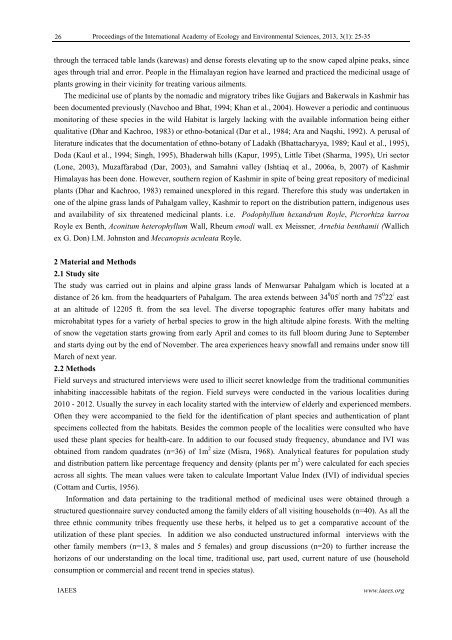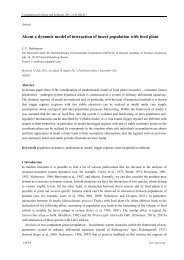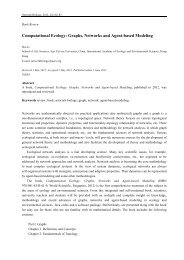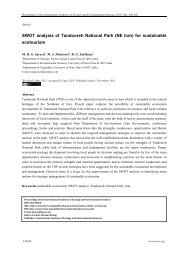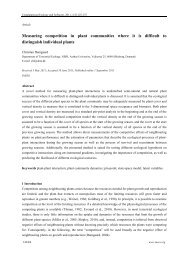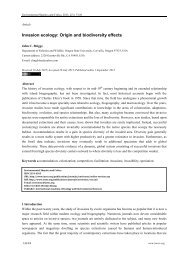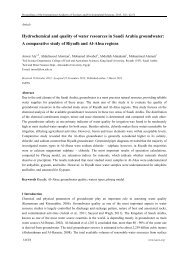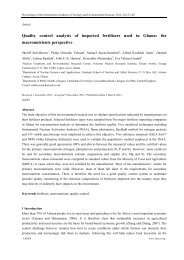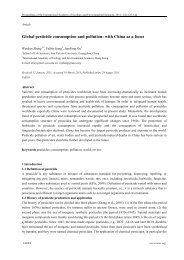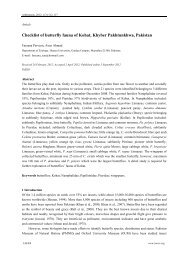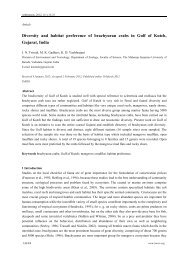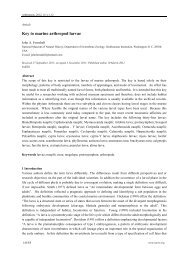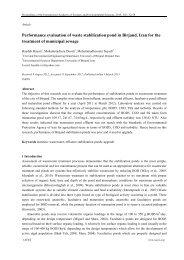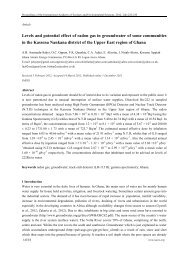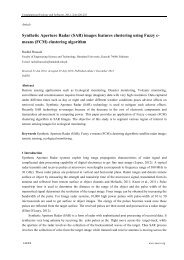Threatened medicinal plants of Menwarsar Pahalgam, Kashmir ...
Threatened medicinal plants of Menwarsar Pahalgam, Kashmir ...
Threatened medicinal plants of Menwarsar Pahalgam, Kashmir ...
You also want an ePaper? Increase the reach of your titles
YUMPU automatically turns print PDFs into web optimized ePapers that Google loves.
26<br />
Proceedings <strong>of</strong> the International Academy <strong>of</strong> Ecology and Environmental Sciences, 2013, 3(1): 25-35<br />
through the terraced table lands (karewas) and dense forests elevating up to the snow caped alpine peaks, since<br />
ages through trial and error. People in the Himalayan region have learned and practiced the <strong>medicinal</strong> usage <strong>of</strong><br />
<strong>plants</strong> growing in their vicinity for treating various ailments.<br />
The <strong>medicinal</strong> use <strong>of</strong> <strong>plants</strong> by the nomadic and migratory tribes like Gujjars and Bakerwals in <strong>Kashmir</strong> has<br />
been documented previously (Navchoo and Bhat, 1994; Khan et al., 2004). However a periodic and continuous<br />
monitoring <strong>of</strong> these species in the wild Habitat is largely lacking with the available information being either<br />
qualitative (Dhar and Kachroo, 1983) or ethno-botanical (Dar et al., 1984; Ara and Naqshi, 1992). A perusal <strong>of</strong><br />
literature indicates that the documentation <strong>of</strong> ethno-botany <strong>of</strong> Ladakh (Bhattacharyya, 1989; Kaul et al., 1995),<br />
Doda (Kaul et al., 1994; Singh, 1995), Bhaderwah hills (Kapur, 1995), Little Tibet (Sharma, 1995), Uri sector<br />
(Lone, 2003), Muzaffarabad (Dar, 2003), and Samahni valley (Ishtiaq et al., 2006a, b, 2007) <strong>of</strong> <strong>Kashmir</strong><br />
Himalayas has been done. However, southern region <strong>of</strong> <strong>Kashmir</strong> in spite <strong>of</strong> being great repository <strong>of</strong> <strong>medicinal</strong><br />
<strong>plants</strong> (Dhar and Kachroo, 1983) remained unexplored in this regard. Therefore this study was undertaken in<br />
one <strong>of</strong> the alpine grass lands <strong>of</strong> <strong>Pahalgam</strong> valley, <strong>Kashmir</strong> to report on the distribution pattern, indigenous uses<br />
and availability <strong>of</strong> six threatened <strong>medicinal</strong> <strong>plants</strong>. i.e. Podophyllum hexandrum Royle, Picrorhiza kurroa<br />
Royle ex Benth, Aconitum heterophyllum Wall, Rheum emodi wall. ex Meissner, Arnebia benthamii (Wallich<br />
ex G. Don) I.M. Johnston and Mecanopsis aculeata Royle.<br />
2 Material and Methods<br />
2.1 Study site<br />
The study was carried out in plains and alpine grass lands <strong>of</strong> <strong>Menwarsar</strong> <strong>Pahalgam</strong> which is located at a<br />
distance <strong>of</strong> 26 km. from the headquarters <strong>of</strong> <strong>Pahalgam</strong>. The area extends between 34 0 05 / north and 75 0 22 / east<br />
at an altitude <strong>of</strong> 12205 ft. from the sea level. The diverse topographic features <strong>of</strong>fer many habitats and<br />
microhabitat types for a variety <strong>of</strong> herbal species to grow in the high altitude alpine forests. With the melting<br />
<strong>of</strong> snow the vegetation starts growing from early April and comes to its full bloom during June to September<br />
and starts dying out by the end <strong>of</strong> November. The area experiences heavy snowfall and remains under snow till<br />
March <strong>of</strong> next year.<br />
2.2 Methods<br />
Field surveys and structured interviews were used to illicit secret knowledge from the traditional communities<br />
inhabiting inaccessible habitats <strong>of</strong> the region. Field surveys were conducted in the various localities during<br />
2010 - 2012. Usually the survey in each locality started with the interview <strong>of</strong> elderly and experienced members.<br />
Often they were accompanied to the field for the identification <strong>of</strong> plant species and authentication <strong>of</strong> plant<br />
specimens collected from the habitats. Besides the common people <strong>of</strong> the localities were consulted who have<br />
used these plant species for health-care. In addition to our focused study frequency, abundance and IVI was<br />
obtained from random quadrates (n=36) <strong>of</strong> 1m 2 size (Misra, 1968). Analytical features for population study<br />
and distribution pattern like percentage frequency and density (<strong>plants</strong> per m 2 ) were calculated for each species<br />
across all sights. The mean values were taken to calculate Important Value Index (IVI) <strong>of</strong> individual species<br />
(Cottam and Curtis, 1956).<br />
Information and data pertaining to the traditional method <strong>of</strong> <strong>medicinal</strong> uses were obtained through a<br />
structured questionnaire survey conducted among the family elders <strong>of</strong> all visiting households (n=40). As all the<br />
three ethnic community tribes frequently use these herbs, it helped us to get a comparative account <strong>of</strong> the<br />
utilization <strong>of</strong> these plant species. In addition we also conducted unstructured informal interviews with the<br />
other family members (n=13, 8 males and 5 females) and group discussions (n=20) to further increase the<br />
horizons <strong>of</strong> our understanding on the local time, traditional use, part used, current nature <strong>of</strong> use (household<br />
consumption or commercial and recent trend in species status).<br />
IAEES<br />
www.iaees.org


